新型冠状动脉分流储备一维计算模型的侵入性验证。
IF 13.3
1区 医学
Q1 CARDIAC & CARDIOVASCULAR SYSTEMS
引用次数: 0
摘要
基于有创血管造影的计算机虚拟分数血流储备(vFFR),可对冠状动脉心外膜病变生理进行无创量化。一维vFFR模型的发展引入了侧支流表示方法,与3D替代方案相比,将模拟时间缩短了几个数量级。然而,在匹配的队列中,没有数据报告一致性和诊断准确性,也没有数据与已建立的FFR替代方案进行比较。方法与结果我们使用了5种不同侧支血流表示的1D模型来计算104条动脉的vFFR。最简单的模型忽略了侧支流,第二和第三模型分别利用血管解剖来均匀分布侧支流并将其划分为分支。最后两种一维模型还使用主容器内的模拟压力来调节侧支流量大小。为了便于解释,还报道了3D vFFR、视觉评估和静息侵袭性压力评估(Pd/Pa)的诊断准确性。中位FFR为0.81[0.73 - 0.88],46例(44%)病变血流动力学显著。在区域侧分支流向分叉的1D模型中,FFR达到了最佳一致性(诊断阈值的平均偏差为-0.03,95%一致性界限为-0.23至0.20)。5种1D模型的诊断准确率无显著差异,曲线下面积(AUC)值在0.68 ~ 0.74之间。1D vFFR的诊断准确性优于视觉评估,与3D vFFR相当,低于有创静息压力评估。vFFR的1d模型有助于心外膜病变严重程度的快速计算机评估。解剖侧支流的包含轻度改善了一致性,但额外的模拟压力的包含是不利的。1D模型的一致性与3D模拟相当。然而,目前的一维模型还不够精确,不足以表明它们可以完全取代基于线的评估。本文章由计算机程序翻译,如有差异,请以英文原文为准。
Invasive validation of novel 1D models for computation of coronary fractional flow reserve.
INTRODUCTION
Computed virtual fractional flow reserve (vFFR), derived from invasive angiography, non-invasively quantifies coronary epicardial lesion physiology. Developments of 1D vFFR models have introduced methods of side-branch flow representation and reduced simulation time by several orders of magnitude versus 3D alternatives. However, no data exist reporting agreement and diagnostic accuracy in a matched cohort or giving comparison to established FFR alternatives.
METHODS AND RESULTS
We used five 1D models, which differed in their side-branch flow representation, to compute vFFR in 104 arteries. The simplest model ignored side-branch flow, the second and third models used vessel anatomy to homogenously distribute side-branch flow and regionalise this to bifurcations respectively. The final two 1D models additionally used simulated pressure in the main vessel to modulate side-branch flow magnitude. To aid interpretability, diagnostic accuracy was also reported for 3D vFFR, visual assessment and resting invasive pressure assessment (Pd/Pa). Median FFR was 0.81 [0.73 - 0.88] and 46 (44%) lesions were haemodynamically significant. Optimal FFR agreement was achieved with the 1D model that regionalised side-branch flow to bifurcations (mean bias at diagnostic threshold -0.03, 95% agreement limits -0.23 to 0.20). Diagnostic accuracy did not differ significantly between the five 1D models, with area under the curve (AUC) values ranging 0.68 to 0.74. Diagnostic accuracy for 1D vFFR was superior to visual assessment, comparable to 3D vFFR and poorer than invasive resting pressure assessment.
DISCUSSION
1D models of vFFR facilitate rapid in-silico assessment of epicardial lesion severity. Inclusion of anatomical side branch flow mildly improved agreement, but the additional inclusion of simulated pressure was not beneficial. Agreement of 1D models was comparable to 3D simulations. However, current 1D models are not sufficiently accurate to suggest they may entirely replace wire-based assessment.
求助全文
通过发布文献求助,成功后即可免费获取论文全文。
去求助
来源期刊

Cardiovascular Research
医学-心血管系统
CiteScore
21.50
自引率
3.70%
发文量
547
审稿时长
1 months
期刊介绍:
Cardiovascular Research
Journal Overview:
International journal of the European Society of Cardiology
Focuses on basic and translational research in cardiology and cardiovascular biology
Aims to enhance insight into cardiovascular disease mechanisms and innovation prospects
Submission Criteria:
Welcomes papers covering molecular, sub-cellular, cellular, organ, and organism levels
Accepts clinical proof-of-concept and translational studies
Manuscripts expected to provide significant contribution to cardiovascular biology and diseases
 求助内容:
求助内容: 应助结果提醒方式:
应助结果提醒方式:


